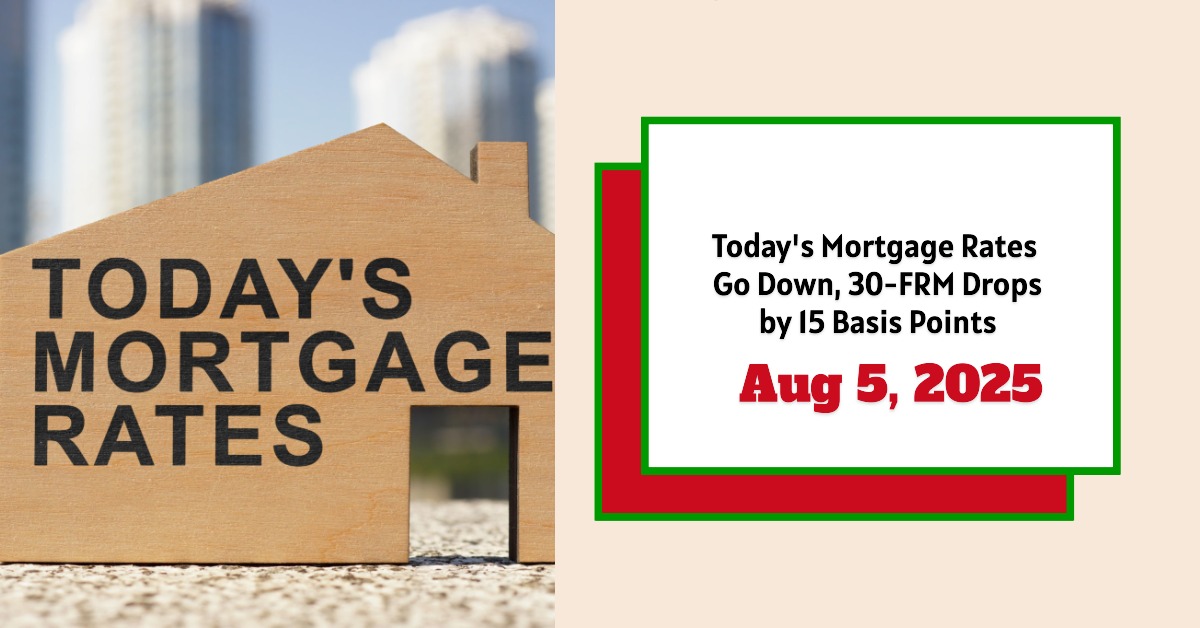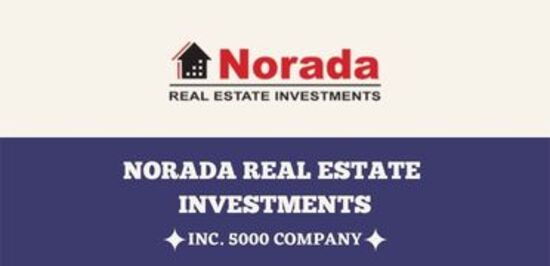As of August 5, 2025, mortgage rates have dropped slightly for homebuyers but refinance rates have edged higher. The national average 30-year fixed mortgage rate stood at 6.67%, a decline of 15 basis points from last week’s 6.82%. On the other hand, the average 30-year fixed refinance rate rose to 7.12%, up 19 basis points from last week’s 6.93% (Zillow).
This mixed movement reflects current economic conditions and Federal Reserve policies, which we’ll explore in depth. Whether you're shopping for a new home or considering refinancing, understanding these rate changes can help you navigate your financing options better.
Today's Mortgage Rates – August 5, 2025: Rates Go Down, 30-FRM Drops by 15 Basis Points
Key Takeaways
- 30-year fixed mortgage rates dropped to 6.67%, down 0.15% from last week.
- 15-year fixed mortgage rates also fell slightly to 5.71%.
- Adjustable-rate mortgage (ARM) rates are down modestly (e.g., 5-year ARM at 7.08%).
- Refinance rates increased: 30-year fixed refinance at 7.12%, up 0.19%.
- Federal Reserve's current pause in interest rate changes influences rate stability.
- Economic factors such as inflation and growth slowdowns continue affecting mortgage markets.
Current Mortgage Rates Overview
Mortgage rates are a key factor in the affordability of buying a home. As of August 5, 2025, rates have shifted slightly but remain relatively high compared to historic lows seen a few years ago. Zillow data provides a clear snapshot of today's rates by loan type:
| Loan Type | Rate % | 1W Change (bps) | APR % | 1W Change (bps) |
|---|---|---|---|---|
| 30-Year Fixed | 6.67 | -16 | 7.12 | -16 |
| 20-Year Fixed | 6.41 | -5 | 6.80 | -13 |
| 15-Year Fixed | 5.71 | -17 | 6.02 | -16 |
| 10-Year Fixed | 5.48 | -26 | 5.84 | -28 |
| 7-Year ARM | 7.08 | -14 | 7.59 | -29 |
| 5-Year ARM | 7.08 | -46 | 7.71 | -21 |
Source: Zillow, August 5, 2025
Government-backed loans show small mixed movements with the FHA 30-year fixed rate slightly up while VA loans dipped marginally:
| Government Loan Program | Rate % | 1W Change (bps) | APR % | 1W Change (bps) |
|---|---|---|---|---|
| 30-Year Fixed FHA | 7.25 | +5 | 8.27 | +4 |
| 30-Year Fixed VA | 6.27 | -2 | 6.49 | -1 |
| 15-Year Fixed FHA | 5.16 | -36 | 6.12 | -39 |
| 15-Year Fixed VA | 5.78 | -5 | 6.14 | -4 |
Refinance Rates on August 5, 2025
For homeowners considering refinancing, the story is different. Refinance rates have climbed recently, offsetting the small dips we see in purchase mortgage rates. This rise adds complexity for those trying to reduce monthly payments or tap equity.
| Refinance Loan Program | Rate % | 1W Change (bps) |
|---|---|---|
| 30-Year Fixed | 7.12 | +19 |
| 15-Year Fixed | 5.79 | +6 |
| 5-Year ARM | 7.89 | +27 |
The 30-year fixed refinance rate increased by 19 basis points to 7.12%, while the 5-year ARM refinance rate jumped 27 basis points to 7.89%. In practical terms, this means refinancing now may not offer the lower-cost advantage that many borrowers hope for unless they have an exceptionally high existing mortgage rate.
Understanding the Numbers: What Does This Mean for You?
To put rates in perspective, let’s use an example calculation for a 30-year fixed loan of $300,000:
| Scenario | Rate | Monthly Principal & Interest Payment |
|---|---|---|
| Current Rate (6.67%) | 6.67% | $1,933 |
| Last Week's Rate (6.82%) | 6.82% | $1,951 |
| Refinance Current Rate | 7.12% | $2,011 |
Monthly payments calculated using a basic mortgage calculator, excluding taxes and insurance.
The 15 basis points drop in purchase mortgage rates reduces your monthly payment by about $18, a modest but meaningful savings over the life of the loan. Conversely, the refinance cost is higher than even last week, costing roughly $60 more monthly compared to the current purchase rate.
Federal Reserve Influence on Mortgage and Refinance Rates
The Federal Reserve (Fed) plays a fundamental role in the direction of mortgage rates, though it does not set them directly. Instead, the Fed’s decisions on the federal funds rate impact bond markets and lending costs.
From 2021 through mid-2023, the Fed aggressively raised rates to curb inflation, pushing mortgage rates to levels unseen in 20 years. However, since late 2024, the Fed has paused rate hikes, even cutting rates three times to stimulate growth amid slowing GDP and climbing unemployment.
By mid-2025, the Fed held interest rates steady for five consecutive meetings despite economic headwinds. This pause has helped stabilize mortgage rates, though refinance rates have seen upward pressure probably due to bond market volatility and risk premiums.
Economic Factors Affecting Rates in 2025
Several economic issues are influencing mortgage and refinance rate trends:
- Inflation: Core Personal Consumption Expenditures (PCE) inflation remains elevated (~2.7%), leading lenders to price in higher risk premiums.
- Growth Slowdown: U.S. GDP growth slowed to around 1.2% annualized in the first half of 2025, signaling caution for long-term lending.
- Unemployment: Slight increases to 4.5% unemployment indicate a softer labor market, which can dampen demand for housing loans.
- Tariffs and Global Inflation Pressure: New tariffs are raising import prices, adding to inflation concerns and complicating Fed's policy.
The Fed's dot plot projection sees two interest rate cuts possible before year-end 2025, which could help lower mortgage rates toward 6.0%. However, timing and scale are uncertain, keeping rates elevated for now.
Mortgage Rate Projections and Market Expectations
Looking ahead, the Fed’s September 16-17 meeting is a critical potential turning point. Market odds stand at roughly 47% for a rate cut, reflecting uncertainty. December remains the final likely opportunity for rate reductions in 2025.
Long term, the Fed anticipates a gradual easing of interest rates, potentially reaching near 2.25%-2.5% by 2027. Such a path would bring mortgage rates down but not to the historic lows of the early 2020s.
Related Topics:
Mortgage Rates Trends as of August 4, 2025
Mortgage Rates Predictions for the Next 30 Days: July 22-August 22
Comparing Mortgage Rates Across Loan Terms
Different loan terms come with varying interest rates that fit different financial goals. Shorter terms typically offer lower rates but higher monthly payments.
| Loan Term | Rate % (Purchase) | Rate % (Refinance) | APR % (Purchase) | Comments |
|---|---|---|---|---|
| 30-Year Fixed | 6.67 | 7.12 | 7.12 | Most common, balances cost & payment |
| 20-Year Fixed | 6.41 | N/A | 6.80 | Slightly lower rate, faster payoff |
| 15-Year Fixed | 5.71 | 5.79 | 6.02 | Lower rate, higher payment, less interest |
| 10-Year Fixed | 5.48 | N/A | 5.84 | Best for quick payoff, higher payments |
| 5-Year ARM | 7.08 | 7.89 | 7.71 | Variable after initial period, riskier |
These rates reflect the trade-offs borrowers face: longer terms mean lower monthly payments but more total interest paid over the life of the loan, while shorter terms offer savings through lower interest rates and less overall debt.
Why Refinancing Rates Are Rising While Purchase Rates Fall
The divergence between purchase mortgage rates and refinance rates often puzzles borrowers. The main reasons:
- Credit Risk: Refinancing can be seen as higher risk by lenders, especially if borrowers have tapped equity or changed credit profiles.
- Market Volatility: Bond markets, which closely influence mortgage rates, are more sensitive to economic uncertainty, affecting refinance rates more sharply.
- Loan Costs: Refinances often involve additional fees, causing lenders to charge a premium in higher rates to cover those costs.
This trend suggests refinancing may be less beneficial unless you currently have a very high interest rate or expect rates to rise further.
Personal Thoughts and Market Insights
Having observed mortgage market cycles for over a decade, this current phase reminds me of periods of careful balance between inflation control and economic growth. While rate cuts are anticipated, waiting for them involves risks too—home prices could move, or personal financial situations can change.
The stability in purchase rates is somewhat reassuring for buyers hesitant about timing. On the other hand, rising refinance rates signal caution for those hoping to quickly lower payments or cash out equity.
Transparency and timing will be crucial. Borrowers should stay informed about Fed announcements and local market conditions. Mortgage decisions today need to consider both the current rate environment and potential short-term fluctuations.
Capitalize Amid Rising Mortgage Rates
With mortgage rates expected to remain high in 2025, it’s more important than ever to focus on strategic real estate investments that offer stability and passive income.
Norada delivers turnkey rental properties in resilient markets—helping you build steady cash flow and protect your wealth from borrowing cost volatility.
HOT NEW LISTINGS JUST ADDED!
Speak with a seasoned Norada investment counselor today (No Obligation):
(800) 611‑3060
Also Read:
- Will Mortgage Rates Go Down in 2025: Morgan Stanley's Forecast
- Mortgage Rate Predictions 2025 from 4 Leading Housing Experts
- Mortgage Rate Predictions for the Next 3 Years: 2026, 2027, 2028
- 30-Year Fixed Mortgage Rate Forecast for the Next 5 Years
- 15-Year Fixed Mortgage Rate Predictions for Next 5 Years: 2025-2029
- Will Mortgage Rates Ever Be 3% Again in the Future?
- Mortgage Rates Predictions for Next 2 Years
- Mortgage Rate Predictions for Next 5 Years
- Mortgage Rate Predictions: Why 2% and 3% Rates are Out of Reach
- How Lower Mortgage Rates Can Save You Thousands?
- How to Get a Low Mortgage Interest Rate?
- Will Mortgage Rates Ever Be 4% Again?



